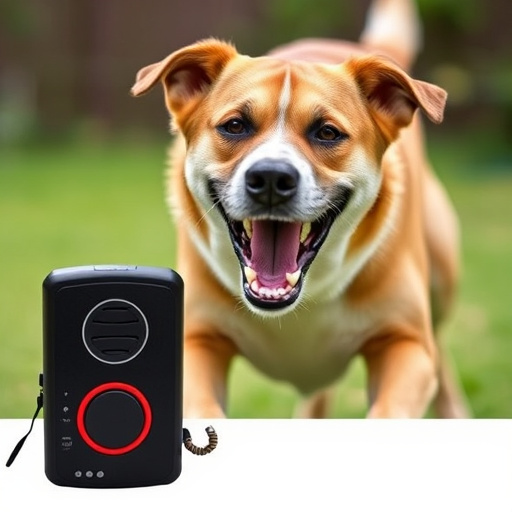Ultrasonic repellets effectively keep large dogs away from homes and gardens using sound waves (25-60 kHz) they find unpleasant. For best results with these non-lethal devices, select models emitting frequencies within the 25-64 kHz range, adjust settings for tailored deterrence, and consider coverage area, durability, and battery life. Training your dog to associate the sound with discomfort is crucial for success, positioning devices strategically and maintaining consistent usage.
Are you tired of persistent dog visits in your garden? Discover the power of ultrasonic repellents, a humane and effective solution. This guide delves into the science behind these devices, focusing on the crucial Ultrasonic Repellent Range for Large Dogs. Learn how to choose the right device, understand its frequency capabilities, and implement training tips for optimal results. Stop unwanted dog intrusions and reclaim your outdoor space.
- Understanding Ultrasonic Repellent Technology
- Determining the Effective Frequency Range for Large Dogs
- How to Choose the Right Ultrasonic Repeller Device
- Training and Implementation Tips for Optimal Results
Understanding Ultrasonic Repellent Technology
Ultrasonic repellents have emerged as a popular and effective solution for keeping dogs away from specific areas, especially in homes and gardens with large dog breeds that require a wider frequency range to be deterred. This technology utilizes sound waves at frequencies beyond human hearing—typically between 25 kHz and 60 kHz—to create an ‘unpleasant’ sensation in dogs. The ultrasonic range for large dogs is particularly crucial as these animals often have reduced sensitivity to higher-pitched sounds, requiring a more intense frequency to be effective.
These devices emit high-frequency sound pulses that are thought to disturb dogs’ hearing or sense of balance, causing them to avoid the area. The technology is designed to be safe and humane, as it does not cause physical harm but rather leverages a dog’s natural aversion to certain sounds. This makes ultrasonic repellents a preferred choice for pet owners seeking non-lethal methods to protect their spaces from unwanted canine visitors.
Determining the Effective Frequency Range for Large Dogs
When considering an ultrasonic repellent for large dogs, understanding the effective frequency range is key. These devices emit high-frequency sound waves that are generally above the human hearing threshold but can be irritating to canines. However, not all ultrasonic repellents are created equal. For larger breeds of dogs, a more powerful ultrasonic range—typically between 25 to 64 kHz—is often required to effectively deter them from unwanted behaviors like barking or trespassing. This higher frequency ensures the sound waves reach deeper into the dog’s ear canals, providing a stronger signal that can be perceived as annoying or uncomfortable.
The specific ultrasonic repellent range for large dogs should take into account their size and sensitivity. Since larger dogs may have more robust hearing, a device with a higher frequency output is needed to avoid simply being ignored or leaving the behavior unaltered. Moreover, some models offer adjustable settings, allowing users to fine-tune the frequency based on their dog’s needs and preferences, ensuring maximum effectiveness while minimizing any potential discomfort for both the pet and those around them.
How to Choose the Right Ultrasonic Repeller Device
Selecting the right ultrasonic repeller device involves understanding your specific needs, particularly if dealing with large dogs. One key factor is to ensure the device covers an effective ultrasonic repellent range that can handle the size and sensitivity of larger canine species. The Ultrasonic Repellent Range for Large Dogs should be designed to emit high-frequency sound waves that are unpleasant to these dogs without causing harm.
When choosing, consider factors like coverage area, adjustable frequency settings, and battery life. A device tailored to large dogs should offer a wide range—typically 10-15 feet (3-4.6 meters)—and adjustable frequencies to cater to varying sensitivities. Additionally, look for durable construction and a design that is weatherproof to withstand outdoor conditions if you plan to use it in your yard or garden.
Training and Implementation Tips for Optimal Results
Training and implementation are key factors in ensuring the best results from an ultrasonic dog repeller, especially when dealing with large dogs. First, identify the specific frequency range that is effective for large canines; typically, ultrasonic repellents target frequencies between 25-60 kHz, which are inaudible to humans but irritating to dogs. Next, condition your pet by playing the repellent sound at a low volume while offering treats and praise. Gradually increase the volume over time until your dog shows signs of discomfort. This process helps your dog associate the frequency with an unpleasant sensation rather than fear or aggression.
Once trained, strategically place the repeller in areas where unwanted dog activity occurs. Ensure it is positioned properly to cover the desired space effectively, taking into account factors like wind direction and potential obstacles. Consistency is crucial; regularly play the repellent sound at varying times and volumes to reinforce the training. Remember, an ultrasonic repeller should be used as a deterrent, not a punishment, so always monitor your pet’s reaction and adjust usage as needed for optimal effectiveness.
When it comes to dealing with large dogs, understanding the specific ultrasonic repellent range is key. By choosing a device that covers an effective frequency range tailored for larger breeds, you can ensure successful training and deterrence. Remember, the right tool with optimal settings and consistent training will help train your dog away from unwanted behaviors. With patience and persistence, an ultrasonic repeller can be a game-changer in creating a peaceful environment for both you and your canine companion.
